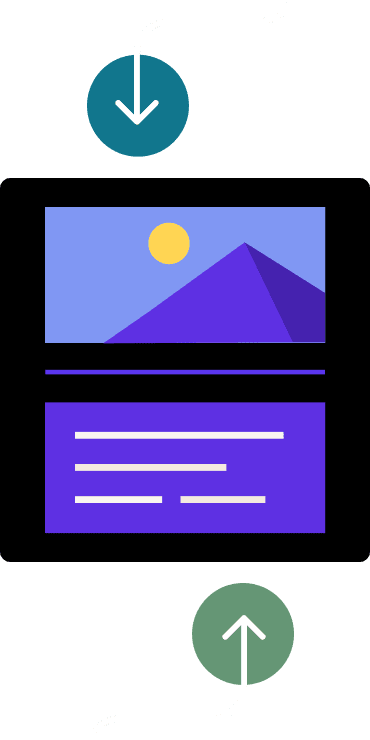A lead magnet is one of the best ways to capture potential clients who are interested in your expertise. Use these lead magnet ideas to get started and leverage content to build your email list!

Digital lead generation is an extremely powerful tool for independent businesses. It enables you to nurture interested clients and create a healthy pool of consistent business.
To build your email list, you can use a variety of effective lead magnet ideas and strategies, including promotions, advertising, and content partnerships, to attract potential customers. But one of the most effective lead generation strategies for independent businesses is creating lead magnets.
With some up-front effort and valuable content, your lead magnets can attract targeted audiences. When users sign up for them and join your email list, you’ll have a group of qualified leads who you can then nurture and move toward converting into clients.

Jump to:
- What is a lead magnet?
- What makes an effective lead magnet?
- 6 lead magnet ideas
- Templates
- Worksheets
- Checklists
- Whitepapers or ebooks
- Tutorials or workshops
- Quizzes
- How to create a lead magnet
- Best practices for developing lead magnets
What is a lead magnet?
A lead magnet is a term for gated content you provide — such as a free trial, worksheet, or template — in return for contact information from your target audience. It’s one of the engines that can power your digital marketing lead generation strategy.
Reports indicate that up to 50% of marketers who leverage lead magnets get higher conversion rates as a result. The most popular lead magnets include e-books, webinars, video content, and free tools, each serving as a valuable piece of content.
Lead magnets, coupled with an opt-in form, give your sales team a direct line of contact with potential customers. They are essential tools for converting leads into customers. This is because the calls to action attached to lead magnets ask people to provide their email addresses and give you permission to reach out to them for relevant offers in the future. As opposed to paid media, your lead magnets are owned media you can repeatedly leverage through repurposing and remarketing.
Additionally, lead magnets are vital milestones in your lead generation pipeline. They can help turn outer-funnel audiences into qualified leads. Because lead magnets are targeted to your ideal audience and related to your services, you know that people who sign up for them have the potential to move through your sales funnel and convert.
That’s why they’re called magnets — they attract audiences suitable for lead nurturing.
What makes an effective lead magnet?
In a nutshell, a valuable lead magnet is relevant to your target customers, useful, and actionable. It should support a topic they’re already interested in and give them something more helpful than a standard blog post or landing page.
Instead of just reading information on the topic, the lead magnet gives them a way to act on the information or continue learning about it in a different way. Here are some other characteristics of the most successful lead-generating tools.
Relevant to the concerns of your target audiences
Lead magnets, like your unique services, address specific objectives and pain points that your ideal client personas have. Though it might not be able to solve all of their problems, it gives them some solutions.
Well-crafted lead magnets address pain points associated with your buyer personas and prove that you have the capability to meet their needs. Because of the solution, you can provide through a worksheet or tool, they’ll have a greater understanding of what your brand does and may keep you in mind if they’re thinking about using services like yours.
Timely for the appropriate stage of the customer journey
Effective lead magnets are key components of a streamlined sales processuseful for your target audiences in their specific stage of the customer journey. By integrating Google Analytics, you can track the engagement and conversion rates of these lead magnets to optimize your marketing strategies. For potential clients at the very top of your funnel, your lead magnets should be purely informational and associated with a topic they’re already researching. At this stage, keyword research is the most helpful for developing ideas, which you can then turn into white papers, online courses, worksheets, and more.
On the other hand, buying guides and feature breakdowns are ideal for leads further along in their customer journey. They might already know about your brand but want more specific information about your services.
Before you create any lead magnets, they should have a clear purpose tied to a stage of your lead generation funnel.
6 lead magnet ideas and examples
So what types of content generate the most leads? If you’re just getting started, I recommend testing different types of lead magnets to see what works with your audience as well as what your business offers.
Start by evaluating each of your services and see how you can spin parts of them into different content types. Here are six lead magnet examples you can use to get started:
1. Templates
Templates are a great lead magnet, whether you offer B2B or B2C services. Everyone’s operating on limited time these days, so offering a tool that eliminates work for them is always helpful.
Templates for design work might be the first thing that comes to mind, such as social media assets, sales collateral, and more. However, many other types of business owners can also use templates.
If you’re a business consultant, for example, consider setting up template spreadsheets that your clients can use for tracking business goals, finances, and more.
Keep in mind that templates can be one of the most time-consuming to put together on your end, but they can have some of the greatest value.
2. Worksheets or cheat sheets
Unlike templates, worksheets and cheat sheets can be some of the easiest types of lead magnets to create. That’s because these pair the best with blog posts and content you might have already created.
For example, if you write a blog post about setting up a QuickBooks account (say if you’re an accountant), you can then provide a downloadable cheat sheet with the most important information.
If you offer services that require a lot of brainstorming from your clients, worksheets are also a great way to help them get their wheels turning. Consultants can offer worksheets geared toward developing business goals, for example.
3. Checklists
Checklists are a great way to consolidate your content into another lead magnet that’s easy to develop. If you tend to walk your clients through a series of steps, that list can be a valuable checklist for them.
For instance, photographers can create wedding photo preparation checklists to help couples consider everything they need in order to book a photographer.
If you’re a consultant or other B2B business, you might also want to consider combining your checklist and template lead magnets. For instance, you can create a checklist template for a project management tool like Notion that anyone can provide their email to use.
4. Whitepapers or e-books
The most popular lead magnet, with nearly 30% of marketers using them, whitepapers or e-books are flexible lead magnets. The whitepaper can be a case study in which you explain how you’ve resolved issues relevant to your audience for other clients. They can be industry or market reports, as well, which give your audience pertinent information they can use across a wide range of purposes while positioning you as an industry or sector leader with the numbers and insight they require.
Because they’re so broad, you can customize whitepapers and e-books to suit your purposes and even make them a regular campaign (i.e. annual reports). Depending on how well previous lead magnets of the same type perform, you can also spin them into a series (multiple case studies, seasonal reports, and more).
5. Tutorials or workshops
Tutorials are essentially short-form courses that are focused on a singular task or subject matter in a more comprehensive approach compared to templates and in an instructional manner as opposed to informational content like e-books.
Note that tutorials are often sought after by users who want to find the right way to do something, and as such are often free and broad, so if you want to use tutorials as lead magnets, you will have to offer something valuable to your target market and specific enough that something similar is not readily accessible elsewhere.
Workshops can be a great option, though they can take a long time to develop. You can always record a few workshop sessions that are available for free, then gate the rest under a paywall.
6. Quizzes
Quizzes, particularly, straddle the line between entertainment for your audience and useful content that reinforces knowledge. They can easily draw in audiences who are earlier in their customer journey but are keen on double-checking the knowledge they already have about your subject matter.
You can also design your quizzes in a way where after each answer, you provide additional context and best practices to add more value. This way, you can even exceed expectations and more successfully encourage quiz-takers to share the quiz with like-minded audiences.
How to create a lead magnet
Creating a lead magnet takes a bit of setup work, but it can lead to long-term returns without much upkeep. Follow these steps to create a lead magnet.
- Create your content – Create your lead magnet using the best platform. If you’re building a template, you might want to use Canva or a simple PDF. If you’re building a tutorial or online course, you may need to use YouTube or another course platform.
- Create your lead form – Next, you’ll need to ensure your gated content is behind a form so you can collect email addresses and other information. You can use HoneyBook lead forms to build branded, interactive forms that include multiple actions.
- Embed your lead form on a blog post or landing page – Your lead magnet should be discoverable and have enough context for visitors to provide their information. That may mean finding a piece of content that aligns with it or building a new page where you can embed your contact form.
- Set up email marketing sequences to nurture your leads – Once leads provide their information, you need to ensure they’ll be properly nurtured to move toward booking with you. Use your email marketing software to create nurture sequences for each lead magnet, ensuring they’re personalized and specific.
- Review your lead magnet performance – Once your site visitors start downloading your lead magnets, be sure to track performance through your contact forms, your website analytics (by using Google Analytics), and your email marketing performance to see what conversion looks like.
Best practices for excellent lead magnets
Lead magnets take a lot of work, but when done correctly, you can reuse them and repurpose them to continue reaping the benefits.
To get the most out of your tools, keep in mind these best practices.
- Optimize your landing pages – When you build your lead magnets, the best way to introduce them is through a landing page on your website. It might be a blog post or a standalone page. Either way, make sure you’re using quality content and clearly communicating the value of your lead magnet.
- Build effective contact forms – When your visitors are interested in what you have to offer, it’s important to eliminate any friction between them and your lead magnet. Make sure you’re building simple contact forms that only collect essential contact details without turning leads away.
- Leverage SEO and content marketing – Make sure you pair your compelling lead magnets with SEO research and content marketing efforts you’re already using to attract your ideal customers. By optimizing your content for search engines, you can increase the visibility of your lead magnets and reach a wider audience. As we mentioned before, many of your blog posts can be great starting points, and keyword research can help you understand what your audience is looking for.
- Create a promotion strategy – Once you’ve put work into your lead magnets, such as an ebook lead magnet, don’t just wait for people to find them. Be sure to promote them on your social media posts, offer them throughout your website, and more.
- Don’t give everything away for free – Lead magnets that align with your marketing goals should help solidify your brand and entice high-quality leads to work with you. Be cautious not to offer content for free that is typically paid for. Finding the right balance between valuable freebies and paid offerings may take some time, so consider this carefully as you develop and experiment with your downloadables and tools.
- Audience Segmentation – Use lead magnets to segment your audience for more targeted marketing efforts. Offer different lead magnets to different segments based on their interests or needs to gather specific information and tailor your messages accordingly. This can lead to higher engagement and conversion rates by speaking directly to each segment’s unique preferences.
Lead magnet FAQs
Are lead magnets worth it?
Yes, lead magnets are worth it. They help capture potential clients interested in your expertise and build your email list, enabling you to nurture leads and secure consistent business.
What is another name for a lead magnet?
Another name for a lead magnet is gated content, which refers to valuable material, such as e-books or webinars, that is accessible to users only after they provide their contact information, typically their email address, making it an effective tool for lead generation.
Does a lead magnet have to be free?
No, a lead magnet does not have to be free. While many lead magnets are offered for free to entice potential customers, some businesses may choose to offer exclusive or premium content as a lead magnet, requiring users to pay or provide additional information to access it.
What is a high-value lead magnet?
A high-value lead magnet is one that offers significant benefits or solves a pressing problem for the target audience. It is typically relevant, actionable, and provides unique insights or solutions that are not easily found elsewhere.
Where should I put my lead magnet?
You should put your lead magnet where it will be most visible and relevant to your target audience. This could include on your website, in blog posts, on social media, or as part of email campaigns. The key is to make it easily accessible and attractive to your audience wherever they interact with your brand.
Capture the right leads with HoneyBook
You could have the best lead magnets in the world, but if you’re not capturing them, your efforts will go nowhere.
Using HoneyBook, you can create customizable, branded contact forms that you can embed onto your websites. When someone fills them out, you can set up an automated sequence to send your lead magnet to your audiences. You can easily personalize each form to suit your needs, and you can do so quickly and without the need for in-depth technical knowledge.

Use HoneyBook to capture leads and book instantly in a single step.



